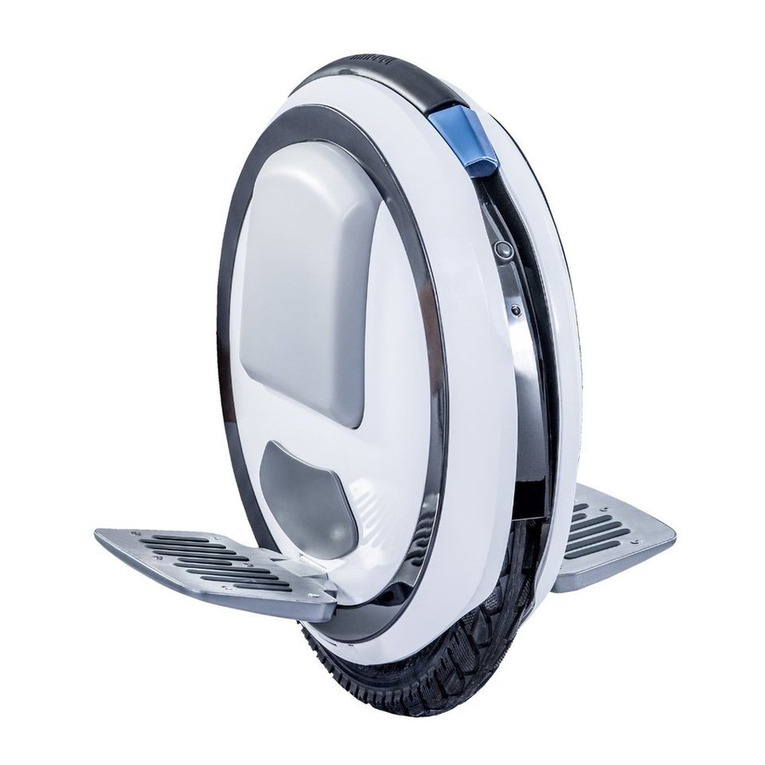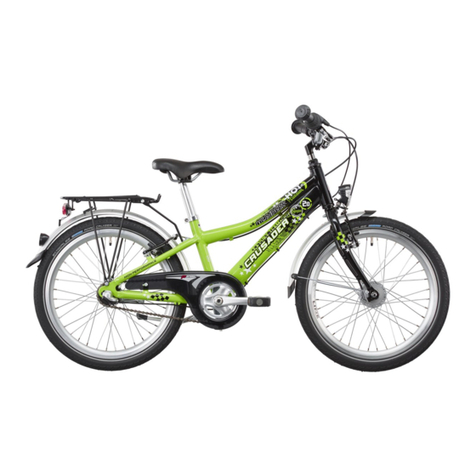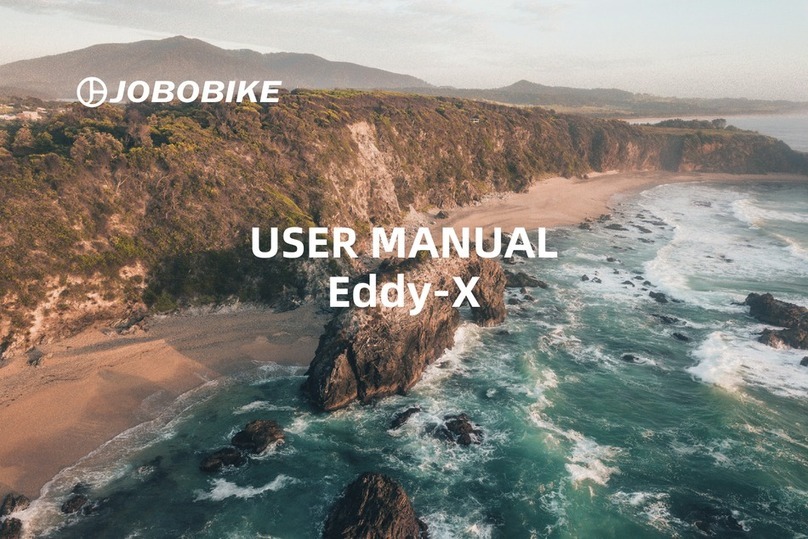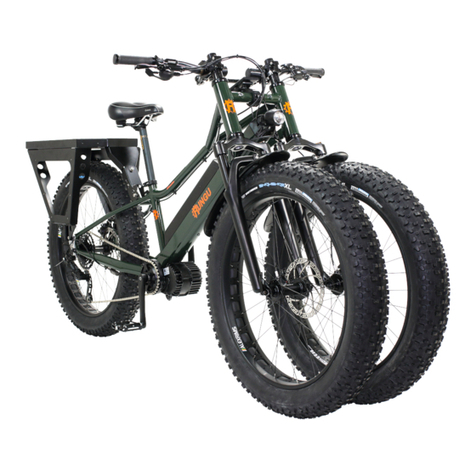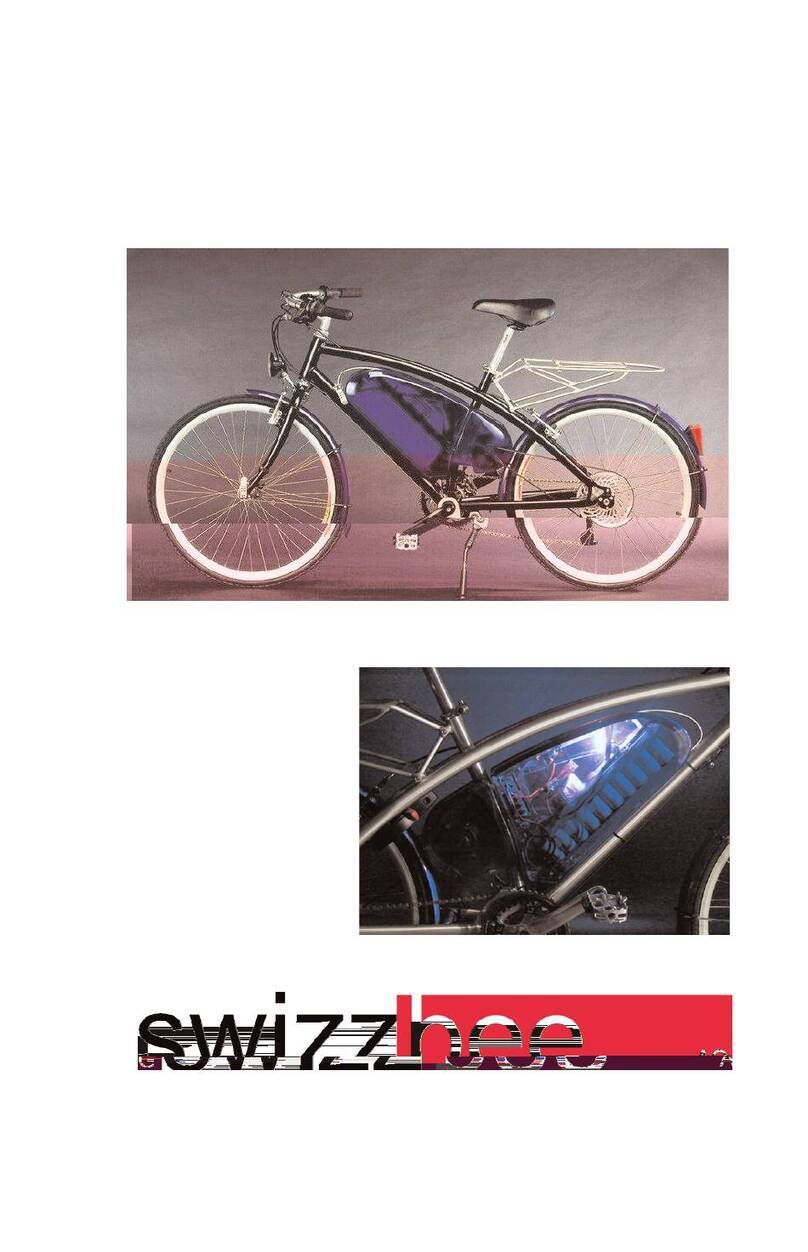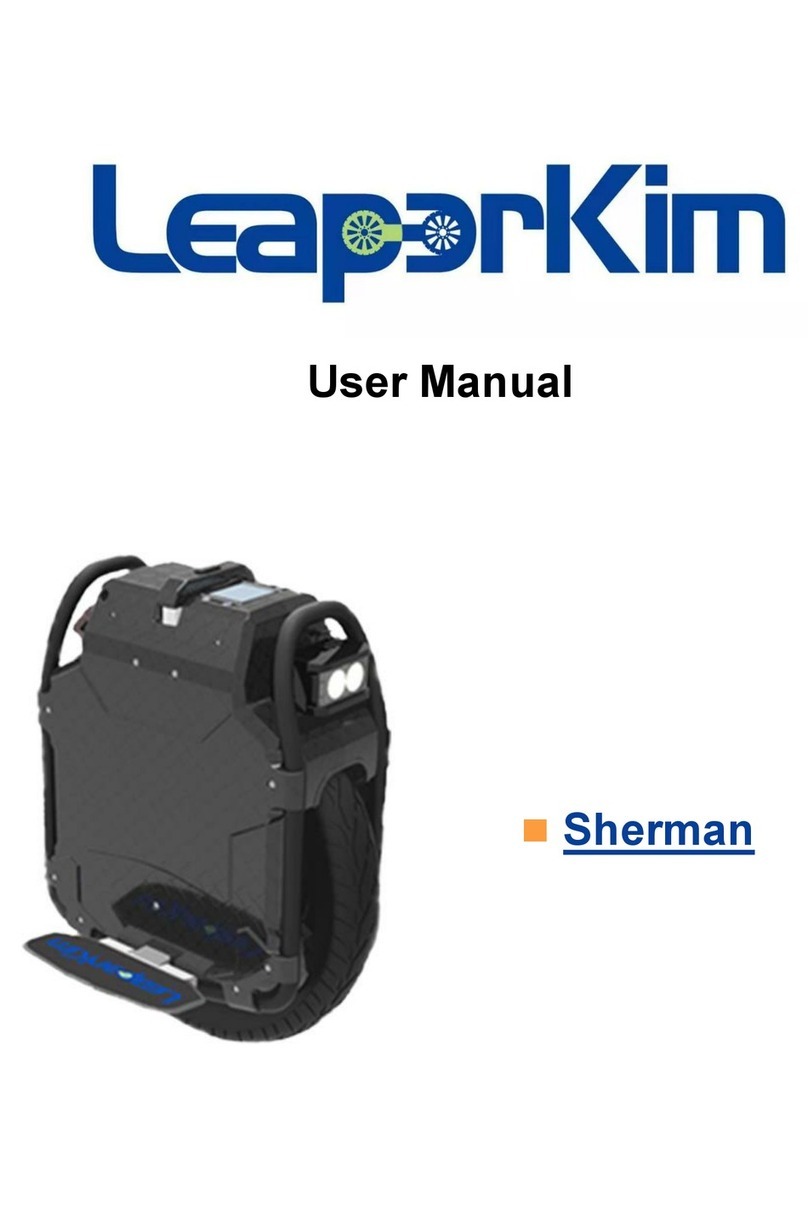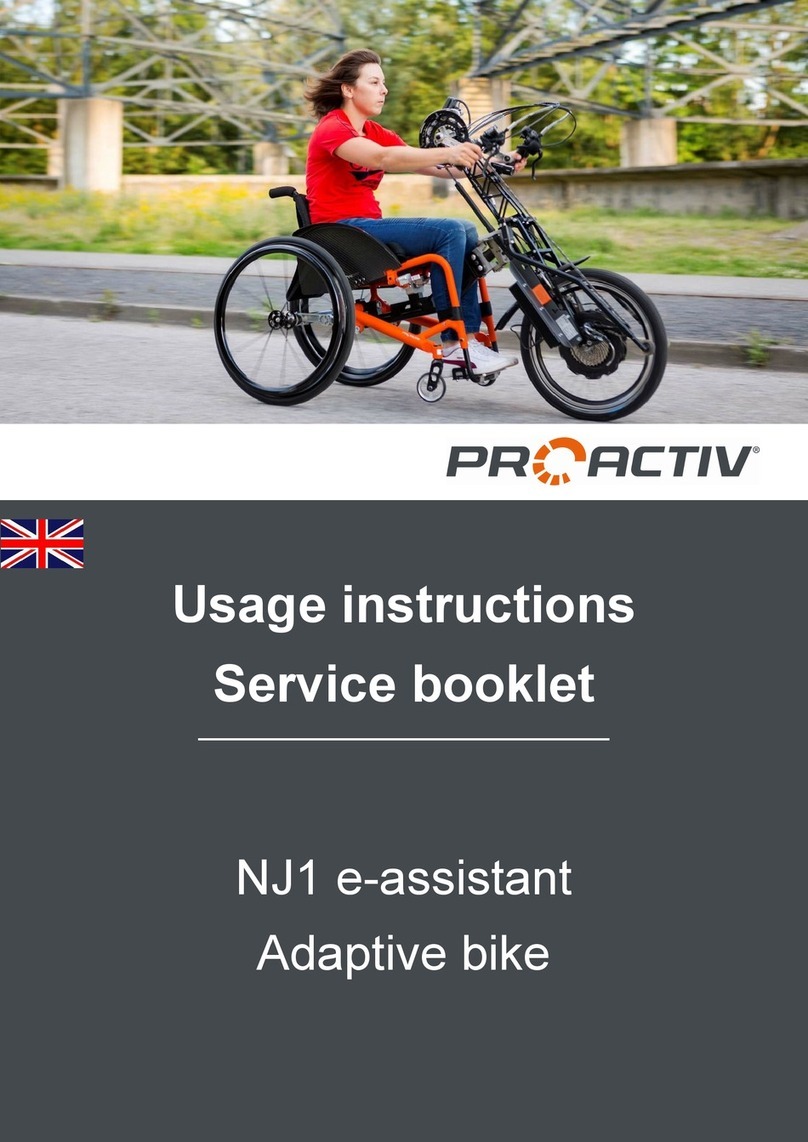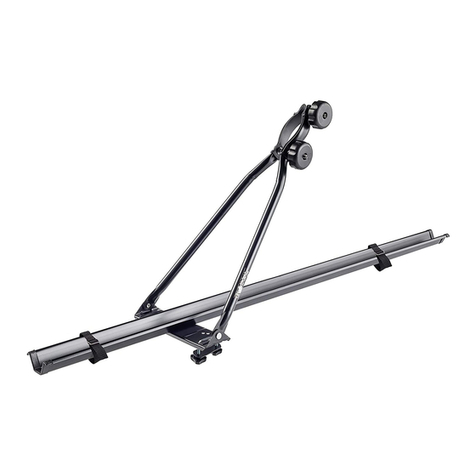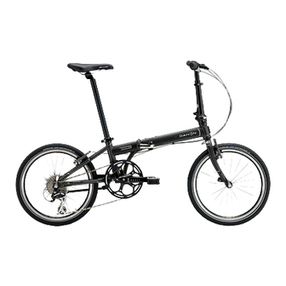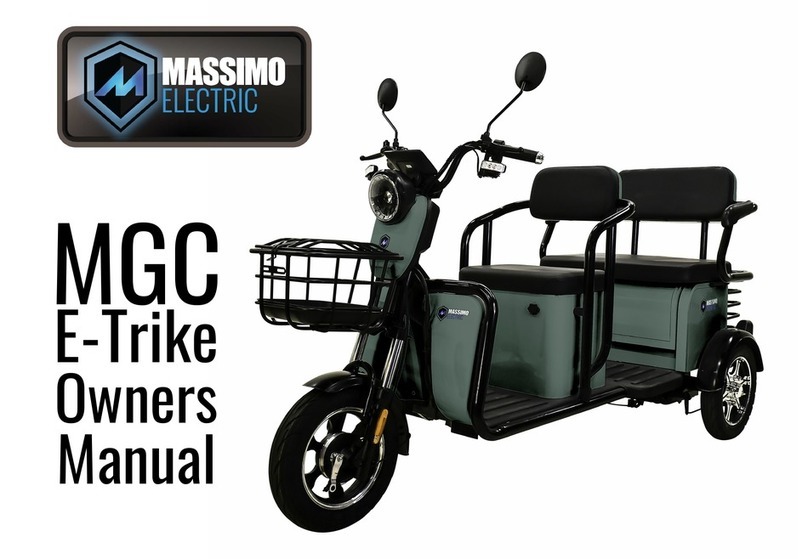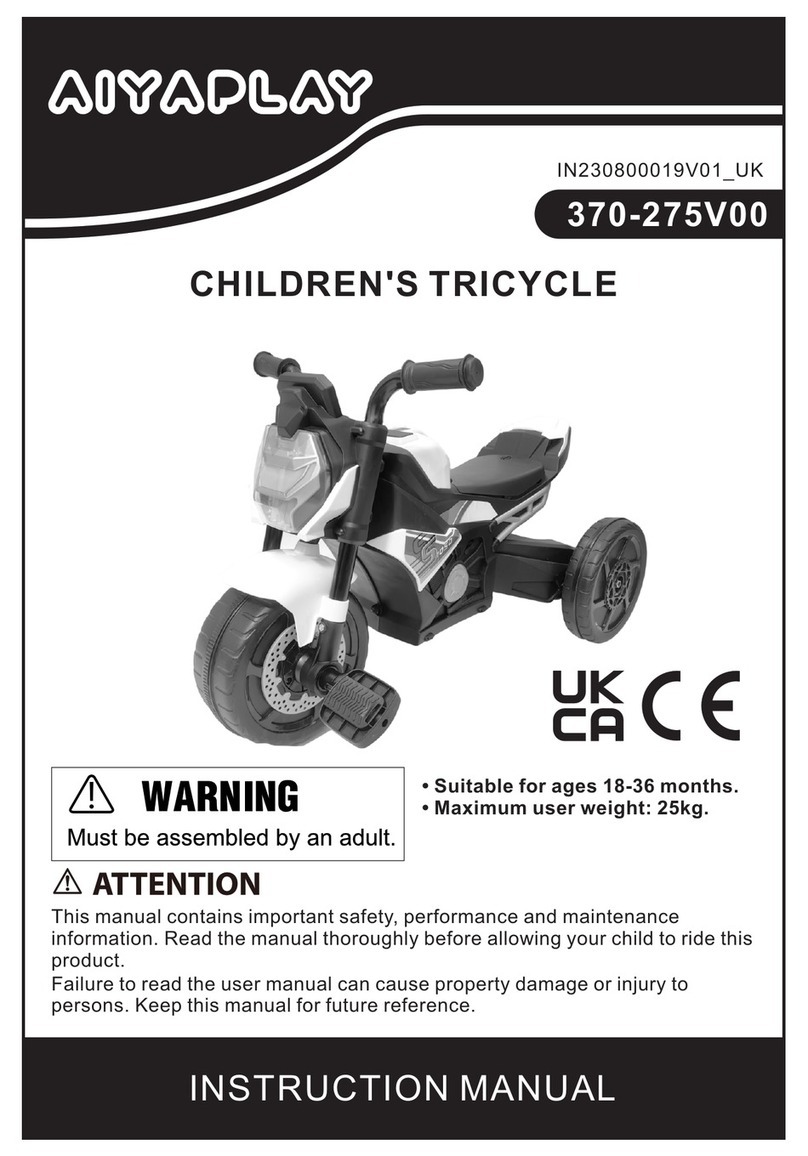Melon Slice User manual

INDEX
Pages:
Operations and Safety
Frame Size 2
Saddle Adjustment 3-4
Safety Checklist 5-7
Helmets 8
Riding Safely 8-11
Operating Gears and Brakes 12-13
Bicycle Assembly and Tuning
Assembly Instructions 14-21
Folding Instructions 22-24
Bicycle Care
Basic Maintenance 25-29
Wheels and Tires 30-39
Headset 40-42
Brakes 43-45
Drivetrain 46-48
Crank Set 49-52
Chain 52-54
Reflectors 54-55
Troubleshooting 56-58
Warranty 59
1

FRAME SIZE
Choosing the appropriate frame and wheel size is impera-
tive when purchasing a new bicycle. For safe riding the size
of your bicycle should properly match your build.
The melon slice folding bike is provided as a one size fits all
bicycle. It can accommodate a height range of 4’8” to 6’3”
in riders. The rider weight limit is 240 lbs.
WARNING:
For safe riding your bicycle should match your
size correctly, otherwise you may lose control
and fall. Ideally there should be a minimum clear-
ance of 25mm between the crotch of the in-
tended rider and the top frame tube of the bike,
while the rider straddles the bicycle with both
feet flat on the ground.
Clearance over the top of the frame ensures that the rider
can safely stand astride the bike when forced out of the
saddle, such as stopping at traffic lights. Frame clearance
is not usually an issue with folding bikes as the frame’s top
tube is only 23.5”.
The melon slice is not designed to fit children. It is not
recommended that children ride this bike.
2
Warranty
Melon Bicycles warrants that any bicycle purchased from
an authorized Melon Bicycle dealer, or from Melon Bi-
cycles directly shall be free from defects in materials and
workmanship for a period of five (5) years from the date
of purchase. This warranty shall extend only to the origi-
nal owner of the bicycle. All components are covered by
the components manufacturers’ warranties. Paint and
finish are covered for one (1) year from the date of pur-
chase by the original owner.
This warranty is void in any instance of abuse, misuse,
neglect, improper assembly, improper maintenance or
from the addition of any components not intended for
the specified model. This warranty shall only be valid if
the bicycle is used for its intended purpose, and shall be
voided by the use of the bicycle for any improper pur-
pose, including, but not limited to, jumping, stunt riding,
riding with heavy loads, or any other non-standard usage.
In the event of any issue, Melon Bicycles may seek to
resolve the problem by replacing the damaged part with
the same or comparable part. Any dealer labor charges
or shipping expenses are the sole responsibility of the
bicycle owner. Correction and/or replacement, in the
manner described herein shall constitute full compliance
with any and all warranties. In no instance shall any war-
ranty extend beyond the purchase price of the bicycle.
THE FOREGOING WARRANTIES ARE EXCLUSIVE AND
INLIEU OF ALL OTHER WARRANTIES WHETHER WRIT-
TEN OR IMPLIED.
The terms of this warranty may change without notice.
59

Problem Possible Reason Possible Solution
Chain jumping off
chainwheel sprocket
or chainring
Chainring out of true Re-true if possible or
replace
Chainring loose Secure mounting
bolts
Chainring teeth bent
or broken
Repair or replace
chainring/set
Rear to front derail-
leur side-to-side
travel out of adjust-
ment
Alter derailleur travel
Incorrect gear shifting Derailleur cables
sticking/stretched/
damaged
Lubricate/tighten/re-
place cables
Front or rear derail-
leur not adjusted
properly
Alter derailleurs
Indexed shifting not
adjusted properly
Alter indexing
Steering not accurate Wheels not aligned in
frame
Align wheels correctly
Headset loose or
binding
Adjust/secure head-
set
Front forks or frame
bent
Consult bicycle
mechanic for frame
realignment
TROUBLESHOOTING (Cont’d)
58
SADDLE ADJUSTMENT
Saddle Height:
When your saddle height is adjusted properly, you should
have a small bend in your knee when your foot is at the bot-
tom of the pedal stroke and you are sitting comfortably. If
you have the saddle height too low, you will lose pedaling
efficiency and will have to work much harder-we definitely
don’t want that. If you have the saddle height too high, you
will be stretching just to pedal and your pelvis will have to
rock side to side with each pedal stroke. Adjust the saddle
height by opening and then closing the quick release lever.
3

Saddle Tilt:
For the most comfortable riding position, adjust the saddle
to be as level as possible. Newer riders sometimes desire
the saddle to be pointed downward to ease discomfort in
the groin area. This adjustment will make it difficult to stay
in the saddle, slightly unsafe, and will cause more problems
for the body in the long run. The melon slice folding bike is
provided with a comfortable well padded seat. We suggest
that you allow yourself time to get acclimated to the seat in
the level position if you are new to riding. Adjust the angle
of the saddle by loosening the nut under the saddle on the
right side of the seat post.
Saddle Front to Back:
This adjustment determines how well balanced you are on
the bicycle. If you move the saddle forward, you will end up
with more of your weight being supported by the saddle it-
self. If you move the saddle backwards, you will end up with
more of your weight being supported by your arms and
hands. You can experiment to find the sweet spot that is the
most comfortable riding position for you. Adjust the saddle
position by loosening the nut under the saddle on the right
side of the seat post.
4
Problem Possible Reason Possible Solution
Brake arms loose Secure mounting
bolts
Wobbling wheel Axle broken Replace axle
Wheel out of true True wheel
Hub cones loose Tighten hub bearings
Headset binding Alter headset
Hub bearings col-
lapsed
Replace bearings
Knocking or shud-
dering when brakes
applied
Bulge in the rim or
rim out of true
True wheel or consult
a bike mechanic
Brake mounting bolts
loose
Secure bolts
Brakes out of adjust-
ment
Center brakes and/
or adjust brake block
toe-in
Forks loose in head
tube
Secure headset
Constant clicking
noises when pedaling
Stiff chain link Oil chain
Loose pedal axel/
bearings
Alter bearings/axle
nut
Loose bottom brack-
et/bearings
Alter bottom bracket
Bent bottom bracket
or pedal axle
Replace bottom
bracket or pedals
Loose crankset Tighten crank bolts
Grinding noise when
pedaling
Pedal bearings too
tight
Adjust bearings
Bottom bracket bear-
ings too tight
Adjust bearings
Chain fouling derail-
leurs
Adjust chain line
Derailleur jockey
wheels dirty/binding
Clean and oil jockey
wheels
57

Problem Possible Reason Possible Solution
Slipping Chain Excessively worn or
chipped chainring
Replaice chainring
Chain worn/stretched Replace Chain
Stiff link in chain Oil or replace link
Non compatible
chain/chainring
Consult a professional
bicycle mechanic
Brake not working
correctly
Brake blocks worn
down
Replace brake blocks
Brake blocks/rim
greasy,wet or dirty
Clean blocks and rim
Brake cables are
binding/stretched/
damaged
Clean/adjust/replace
cables
Brake levers are bind-
ing
Alter brake levers
Brakes out of adjust-
ment
Center brakes
Frequent punctures Inner tube old or
faulty
Replace inner tube
Tire tread/casing
worn
Replace tire
Tire incompatible to
rim
Replace with correct
tire
Tire not checked after
previous puncture
Remove any sharp
objedts from tire
Tire pressure too low Inflate tire to correct
pressure
Spoke protruding into
rim
File down spoke
When the brakes are
applied they squeal/
squeak
Brake blocks worn Replace brake blocks
Brake blocks/rim
greasy,wet or dirty
Clean blocks and rim
Brake block toe-in
incorrect
Correct block toe-in
TROUBLESHOOTING
56
SAFETY CHECKLIST
Safety checks are an important part of any ride. In conjunc-
tion with the recommended maintenance in this manual
it is also suggested that a thorough inspection should be
undertaken fortnightly, tightening all nuts and bolts, replac-
ing worn and damaged parts and ensuring all components
are in their correct positions.
WARNING:
Body parts and other objects should be kept
clear from the moving components of the bicycle
when in use, such as the spinning wheels and the
moving chain. When riding always wear appropri-
ate footwear – i.e. shoes that will grip the pedals
and no sandals. Refrain from jumping with your
bike. Jumping puts enormous stress on many
components of your bicycle, especially your front
fork.
Prior to every ride please complete the following safety
checks:
1. Brakes
• Check front and rear brakes are working correctly
• Check brake control cables for wear and ensure they are
oiled and properly adjusted
• Check brake control levers are lubricated and securely
fastened to the handlebar.
• Check brake shoe pads for wear and their positioning in
relation to the rims
5

2. Wheels and Tires
• Check tire pressure is as recommended according to the
specification displayed on the tire sidewall
• Check tires for tread and ensure they do not have any
bulges or excessive wear.
• Check all wheel spokes are firm and are intact
• Check rims run true and are without any obvious buckles
or kinks
• Check that axle nuts are tight. For bicycles equipped
with quick release axles, ensure locking levers are ten-
sioned appropriately and in the closed position.
3. Saddle
• Check the clamp underneath the saddle is firmly secured
to the saddle post
• Check frame clamping mechanism is tightly fastened
• Ensure that the minimum insertion mark cannot be seen
on the saddle pillar
4. Steering
• Check that the handlebar and stem enable correct
steering and are properly adjusted and tightened
• Check that the setting of the handlebars is correct in
relation to the forks and the direction of travel
• Check the head set locking mechanism is appropriately
fixed and fastened
• If handlebar extensions are fitted check they are posi-
tioned and secured correctly
• Ensure the minimum insertion mark cannot be seen on
the handlebar stem
• Ensure the ends of the handlebars and bar ends are
covered or capped.
5. Chain
• Check the chain is lubricated, clean and runs freely
• In wet or dusty conditions service the chain more fre-
quently
6
WARNING:
The reflectors and the reflector mounting brackets
must not be removed from your bicycle. Doing so
may reduce your visibility to other road users, po-
tentially jeopardizing your safety. Serious injury or
death may result if you are hit by another vehicle
unable to see you.
WARNING:
Reflectors should always be used in conjunction
with powered lighting when riding at night, at
dawn, dusk, or at any other time in poor visibility.
Failure to do so is dangerous and may result in
serious injury or death.
When riding at night, in addition to the reflectors, the
bicycle should also be equipped with powered lights. Re-
flective tape on the rider’s clothing is also recommended to
increase visibility.
55

REFLECTORS
The reflectors fitted to your bicycle are not only an impor-
tant safety feature, but a legal necessity as well. Your bi-
cycle should come equipped with one white (front), one red
(rear), and two orange (wheel) reflectors. Each pedal should
also have two orange reflectors fitted.
As a part of your bicycle maintenance ensure that all reflec-
tors are clean, intact and securely fastened. The front and
rear reflectors should be vertically aligned, and the wheel
reflectors should be secured opposite the valve within
75mm of the rim.
To install a chain on a derailleur geared bicycle:
• Thread the chain around the chainwheel, rear sprocket
and derailleur cage with the rivet facing away from the
bicycle.
• Bring the two ends together within the special tool and
punch the rivet into place. Take care not to push rivet
too far through the side plate. Derailleur geared bicycles
can now be fitted with some new types of chains that do
not require special tools to remove or replace. Instead,
a new, special, disposable connecting link is used every
time you disassemble the chain. For further details on
these particular chains, including installation guidelines,
refer to the manufacturer’s specific instructions.
54
6. Bearings
• Check headset, wheel bearings, pedal bearings and bot-
tom bracket bearings
• Check all bearings are oiled, run smoothly and show no
signs of excess movement, grinding or rattling
7. Cranks and Pedals
• Check cranks are securely fastened to the axle and are
straight
• Check pedals are properly and firmly attached to the
crank
8. Derailleurs
• Check the rear mechanism is operating appropriately
• Check control levers are securely anchored
• Check derailleurs, control cables and shift levers are suf-
ficiently lubricated
• If the gear components come with a separate, specific
manual, refer to this for further information
9. Frame and fork
• Check that the frame and fork are straight and intact.
• Replace if either is bent or broken.
10. Safety & Accessories
• Check that all reflectors are attached correctly and vis-
ible
• For riding at night, fit fully functioning dynamo or bat-
tery powered lights
• Check that the bell is fully operational
• Check all additional components on the bike are appro-
priately secured and functioning
7

When riding your bicycle it is recommended that you always
wear an appropriately fitting Country Standards Approved
bicycle helmet.
A bicycle helmet must:
• Carry the Country Standards Approved
• Fit properly
The helmet should be:
• Well ventilated
• Comfortable
• Lightweight
HELMETS
WARNING:
The wearing of helmets is mandatory in many
areas.
Noncompliance may result in an enforceable pen-
alty
RIDING SAFELY
General Rules
• The same road rules used for vehicles apply to cyclists.
Obey the road rules at all times, such as giving way to
pedestrians, and stopping at red traffic signals
• Notify the Road Traffic Authority in your state if further
information is required.
8
To remove a chain on a derailleur geared bicycle:
• Fit the rivet tool so that the punch pin is centered over
any one of the chain rivets.
• Push the rivet almost all the way out, then back out the
punch and remove he tool.
• Holding the chain on both sides of the punched rivet,
bend it slightly to release the link from the rivet.
Adjustment and Replacement
The chains on derailleur geared bicycles are automatically
tensioned by the rear derailleur making manual adjustment
of the chain unnecessary. The chains on derailleur geared
bicycles are narrower, meaning a special tool is needed to
complete any of the procedures.
Check that all links of the chain move freely. Replace the
chain if it appears stretched, broken or causes problems
when changing gears.
53

CHAIN
Inspection and Lubrication
Regular inspection and maintenance of your chain is vital to
guard against premature wear. At least monthly, or after rid-
ing in wet, muddy or dusty conditions, the chain should be
cleaned and lightly oiled. Any excess oil should be removed
and care taken to ensure the lubricant does not come into
contact with the tires or rim braking surfaces.
Lubrication and Replacement - Cartridge Bottom Bracket
Freeplay cannot be removed from a cartridge bottom
bracket. It is a sealed unit and is designed to be replaced
as an entire unit when it is worn out. Once the cranks have
been removed a specific extraction tool is required to re-
move the cartridge bottom bracket. Consult your specialist
bicycle dealer for further advice regarding this process.
52
• Ride on the right side of the road and never against the
traffic.
• Take extra care when attempting to overtake other ve-
hicles and at intersections.
• Indicate intended actions, such as turning or stopping,
by using appropriate hand signals.
• Ride predictably and in a straight line.
• Always ride defensively. You may be difficult to see to
other road users.
• Closely observe the riding terrain. Avoid obstacles
such as pot holes, gravel, wet road markings, oil, curbs,
speed humps and drain grates.
• Be alert. Watch for such things as motorists opening
doors or backing out of concealed driveways.
• Sound your bell for a warning when required.
• Train and tram tracks should be crossed at a 90 degree
and preferably walk your bicycle over.
• Know how your bicycle operates. Practice braking, gear
shifts and if fitted, using toe clips and straps.
• Always apply the rear brake first, then the front when
braking. The front brake is more potent and if it is not
used properly you may lose control and fall.
• Allow reasonable space between yourself and other
vehicles and objects when riding and stopping. Take
note of weather conditions and its possible impact on
safe braking distances. e.g.. Wet riding surfaces increase
braking distances.
• Use leg clips or elastic bands if you are wearing loose
trousers to stop them catching in the chain.
• Ensure your vision or control of the bicycle is not ob-
structed by any items you may be transporting.
• Do not use items that may impede your hearing. e.g.
headphones
9

Wet Weather
• Ride more cautiously in wet weather. Avoid sudden
braking, slow overall riding pace and approach corners
more carefully.
• Brake sooner, stopping distance increases in wet condi-
tions.
• Remember pot holes and slippery surfaces such as line
markings and tram tracks all become more hazardous in
the wet. Try to avoid where possible.
• Cornering traction will also be reduced in wet weather.
Night Riding
• Wear reflective and light colored clothing.
• Reflectors should be fitted correctly to the bicycle and
clearly visible. Riding in the dark should never be un-
dertaken without fully operational front and rear bicycle
lights. The use of bicycle lights is mandatory for night
riding in most Australian States.
• Attach a fully operational lighting set. Lights should have
a white front lamp and a red rear lamp.
• Use a flashing rear light to improve visibility.
• Charge batteries if battery powered lights are to be
used. Check wiring connections for dynamo powered
lights.
• Avoid riding at night if possible. If not, slow down and
opt for familiar roads with street lighting when able
On Road Off Road
• The melon slice is designed for on road riding. Extra
care should be taken when riding on dirt or gravel sur-
faces.
10
Three Piece Crank Replacement
1. Place the crank arm onto the axle.
2. Use a soft mallet to gently tap the crank arm.
3. Reattach the washer and secure the flange nut or bolt
securely to a torque of 27Nm.
4. Replace the dust cover.
After fitting new three piece cranks some additional
maintenance is required as components can become
loose with use. The following adjustments should
be made after several hours of riding, and repeated
two or three times after further use. There after the
cranks should remain secure.
1. Remove the dust cap.
2. Gently tap the crank arm with a mallet.
3. Re-tighten the flange nuts, and refit the dust caps.
51

Lubrication and Adjustment – Three Piece Cranks (Cot-
terless Cranks)
To adjust:
• Turn the lockring on the left side anti-clockwise.
• Turn the adjusting cup until appropriately set.
• Carefully re-fasten the lockring without disturbing the
cup adjustment.
To disassemble:
1. Remove the cranks from the axle.
2. Turn the left side lockring anti-clockwise and remove.
3. Turn the adjusting cup anti-clockwise and remove.
4. Remove the left ball retainer and slide the axle out of
the frame to the left.
5. Turn the right side fixed cup anti-clockwise and remove,
as well as the right ball retainer.
Once the crank is dismantled clean all bearing surfaces and
the ball retainers and check for wear. Replace any damaged
parts and pack grease into the ball bearing retainers. Re-
assemble the crank in the reverse order of the procedure
listed above.
Three Piece Crank Removal
To remove Cotterless cranks you will need to use a spe-
cific removing tool. Follow the outline below to guide you
through the process.
1. Use a coin or a screwdriver to remove the dust cap.
2. Remove the flange nut or bolt and washer after loosen-
ing.
3. Attach the removing tool into the crank and tighten.
4. Turn the screw bolt until the crank comes away from the
axle.
50
Pedaling Technique
• Place the ball of your foot on the centre of the pedal.
• Ensure your knees are parallel to the bicycle frame when
pedaling.
• Keep your elbows slightly bent. This will help to absorb
shock.
• Learn how to use the gears correctly
Hill Technique
• Prior to a climb, gear down and continue gearing down
as necessary in order to sustain pedaling speed.
• By standing up on your pedals you will be able to gener-
ate greater power from each turn of the pedal. This is
useful if you are straining and are using the lowest gear.
• Use the high gears on a descent to prevent rapid pedal-
ing.
• Take extra care when descending. Do not exceed a com-
fortable speed and maintain control.
Cornering Technique
• Before entering a corner brake slightly and begin to lean
your body into the corner.
• The inside pedal should be held at the 12 o’clock posi-
tion and the inside knee angled slightly in the direction
you are turning. The other leg should be kept straight.
• Avoid pedaling through fast or tight corners.
As suggested by the Consumer Affairs Department
riding bicycles with small wheel diameter at excessive
speeds can lead to instability and is therefore not recom-
mended.
CAUTION:
When riding downhill never take your hands off
the handlebars, or feet off the pedals
11

OPERATING GEARS AND BRAKES
Derailleur Gears
Derailleur gears are the most common type of gear sys-
tems used on bicycles. They are the changing mechanism
used to move the drive chain up and down a series of cogs
or sprockets (the cluster or cassette stack) at the rear of
the bicycle and across the chainwheel at the front of the
bike (if fitted). Multispeed bicycles today can range form
5-6 gears to as many as 30. Rear derailleurs are fitted to all
multispeed bicycles while front derailleurs are only present
on those bicycles with the higher number of gears. Gears
enable the cyclist to select the most appropriate pedaling
resistance best suited for the riding conditions. The more
gears fitted to the bicycle the greater choice available to
the rider.
Operating Principles
Although the number of gears present on multispeed bi-
cycles varies greatly, how the gears function remains the
same. The right shifter works the rear derailleur and the left
shifter works the front derailleur. If the pedals are station-
ary or rotating backwards, gears cannot be changed. They
can only be altered when pedaling forward. To achieve a
successful gear change, either moving up or down in gears,
the pedaling pressure must be relaxed. Failure to ease the
pressure when changing gears may result in bicycle damage
or could even cause the rider to lose control. If a rubbing
sound is detected after attempting to alter gears, adjust the
shifter until the sound ceases. Generally the lower gears are
for ascending hills and the higher gears are for descending.
12
WARNING:
Never attempt to force a pedal into a different
sized bicycle crank.
CRANK SET
Inspection and Maintenance
Every month the crank set should be checked to ensure that
it is properly adjusted.
For Three Piece Cranks:
• Check that the crank axle nuts are tight.
• Adjust the bottom bracket bearings as necessary.
• Remove the chain and test for crank movement on the
axle by attempting to move the cranks from side to side
with your hands. Only very slight movement in the bot-
tom bracket should be noted.
• Rotate the cranks. Adjust and oil if they do not spin
freely or a grinding noise is detected.
• Check the chainrings for any broken teeth, and clean off
any excess dirt and grease.
CAUTION:
Always ensure that your Three Piece cranks are
firmly secured before riding. Riding with loose
cranks is potentially hazardous to both the rider
and condition of the crank arms.
49

Attachment
Each pair of pedals has a specific right and left pedal. It is
important that a pedal is never forced into the incorrect
crank arm as the thread is different for the two pedal sides.
The right pedal, as indicated by the “R” stamped on the
end of the axle, screws into the crank on the chainwheel
side of the bicycle in a clockwise direction. The left pedal
is marked with an “L” on the axle, and it is attached to the
other side in an anti-clockwise direction.
To attach, place the pedals into the correct crank arm and
wind on by hand as tightly as possible in the appropriate
direction. Use a 15mm wrench to fasten more securely.
Removing a pedal is the reverse process of attaching. The
right pedals needs to be turned anti-clockwise and the left,
clockwise.
Before fitting any new pedals ensure that the axle thread
size is compatible with the cranks on your bicycle. The two
types of cranks available each have different axle threads.
Cranks that are a one piece design have no separate axle
and are compatible with pedals that have a 1/2” thread.
Three piece crank sets with a separate left and right crank
use a slightly larger 9/16” thread.
48
Hand Grip Shifters
Hand grip shifters are built into the hand grip and attach to
the handlebars. Unlike other types of shifting mechanisms
the hand grip shifters mean you do not need to change
your hand position to select different gears. The rider just
simply twists forwards or backwards dependent upon their
gear selection. By twisting the right shifter toward you, a
lower gear is chosen as a larger rear cog is selected. Twist-
ing this shifter away from you has the opposite effect; a
higher gear is selected as a smaller rear cog is engaged.
Turning the left shifter forward or away from you activates
a smaller, front chainwheel, and a larger, front chainwheel
is engaged by twisting it backwards. The number of gear
changes to occur at any one time corresponds with how
many turns are made of the shifter.
Brakes
V-brakes are activated by pulling of the brake hand levers
located on the bike’s handlebars. The right brake lever
activates the rear brake and the left hand lever activates
the front brake. Always apply the rear brake first and then
slowly add pressure to the front brake.
WARNING:
Applying the front brake first or with a dispropor-
tionate amount of pressure can cause the bike
rider to flip over the front wheel.
13

BICYCLE ASSEMBLY AND TUNING
You will need the following tools for the assembly and main-
tenance of your melon:
Before you unpack your new melon, make sure to keep the
box in the upright position. Open the box from the top.
Assembly Instructions:
14 mm wrench
15mm wrench
Philips screwdriver
Hex allen wrenches:
2mm,2.5mm,5mm, and 6mm
Needle nose pliers
Tire pump
14
Inspection
Every month the pedals should be inspected. Check that:
• Pedals are securely fastened into the cranks. Loose
pedals are a potential hazard for both the rider and the
integrity of the cranks.
• Pedal bearings are adjusted correctly. Alter, grease or
replace if any roughness or looseness is detected in
the pedal bearings when the pedals are moved up and
down, laterally or rotated by hand.
• The front and rear pedal reflectors are clean and firmly
attached.
• If toe clips are fitted, ensure that they are fastened
tightly to the pedals.
Lubrication and Adjustment
The maintenance your pedals need will depend upon
whether or not they can be disassembled to enable access
to the internal bearings and axle. If they cannot be disas-
sembled, every six months a small amount of oil should be
injected onto the inside bearings of pedals. Pedals that can
be fully disassembled should have the bearings removed,
cleaned and greased every six to twelve months. However,
due to the complexity of this task it is recommended that it
be completed by a professional
bicycle mechanic.
47

DRIVETRAIN
The drivetrain consists of the
pedals, chain, chainwheel,
crank set, and freewheel.
These are all the compo-
nents of the bicycle that
transmit power to the rear
wheel.
Pedals
There is a vast range of pedals available, designed for many
different uses. Pedals fitted with toe clips and straps aim to
make the pedaling process easier for the rider. The toe clips
and straps ensure the cyclist’s feet stay correctly positioned
and cause a pulling force, as well as a downward pressure,
to be generated on the pedals. To get the full benefit of
these pedals it is recommended that the rider wear cycling
shoes especially designed for use with toe clips. Consult
your bicycle dealer for instruction on how toe clips and
straps operate.
WARNING:
Pedals fitted with toe clips and straps require a
certain level of skill to operate safely. Riders should
repeatedly practice using such pedals in areas free
from traffic, hazards or obstacles, until operation
becomes a reflex action. Failure to do so could
result in the cyclist losing control of the bicycle and
falling. It is also recommended that the straps be
kept loose initially and gradually tightened as the
rider’s skill in using the pedals increases. However,
toe straps should never be tight when riding in
traffic.
46
You will find three pieces in-
side: the bike, the front tire,
and a box with pedals and
reflectors.
Cut the plastic ties holding
the seat post to the frame
and the piece of foam to the
stem joint.
Remove the foam wrap and cardboard from the bikes
frame. Take off the plastic guards around the top of the
seat tube, both sides of the rear axle, and the bottom of
the front fork.
Spread some grease around the
bottom outside of the seat tube.
Insert the seat post into the seat
tube and tighten the quick release
lever.
15

Raise the stem and tighten it in place by turning the stem
joint.
Release the front brake and
slide the front tire into posi-
tion. Loosen the bolts on
either side of the front wheel
axle and push the axle into the
top of the fork slots firmly. At
the same time, you will need
to make sure that the wheel is
properly centered in the fork.
When you think you have got it
right, tighten the axle nuts with
a 15mm wrench (turn clockwise
on both sides). Spin the wheel
to make sure that it is properly
centered in the fork and does
not wobble. If the wheel is not
centered, loosen the nuts and
try again. Re-attach the front
brake when finished.
16
Brake Shoe Replacement
Check your brakes shoes monthly for any indication of wear.
If the pads are worn past the “wear line” indication (See
diagram), the brake shoes need to be replaced. Always re-
place the brake shoes in pairs – never one side only.
For replacement, disconnect the holding mechanism spe-
cific to your brake type -i.e. a hexagonal nut or an Allen
screw arrangement, or a combination of both. Remove the
worn brake shoes paying careful attention to the order and
position in which the various curved washers and spacers
are attached. Fit the new brake shoes, and tune the angle
and the clearance to the rim as required. Typically, before
the rim clearance can be adjusted the control cable anchor
bolt needs to be loosened and then the cable adjusters
fasten and the cable tensioned. (Refer to the Installation/
Adjustment section relevant to your brake type for detailed
instructions.) Once the adjustments are complete, securely
fasten the brake shoes in place and test that the brakes
are functioning correctly. Do not ride the bicycle until the
brakes are working effectively.
45

Brake Inspection
The brake levers and the brake pads are the two main
components that need to be checked to ensure your brakes
are functioning effectively. Positioning of the brake levers
should be checked to ensure they can be easily reached by
the rider’s hands and alterations made as necessary. Some
brake levers have a screw adjuster to change the distance
between the lever and the handlebar grip. This should be
checked for tightness every three months. Similarly, at least
every three months the brake levers should be tested to
ensure they do not move on the handlebars and each brake
lever moves freely when compressed.
Prior to every ride inspection of the brake pads is recom-
mended. The brake pads must be centered, with approxi-
mately 1.5mm – 2mm clearance between each pad and
the rim when the brakes are not in use. Test that when the
brakes are applied that the brake pads squeeze the rims
sufficiently to stop the bike. Replace the brake pads if the
grooves or pattern has worn away from the surface. Ensure
that the brake pads are firmly secured before every ride
and at least every three months check the tightness of the
numerous bolts and nuts supporting the brake pads.
44
Check the positioning
of the handlebars. The
sweep (handlebar curve
towards the seat) should
be coming straight
back, not upwards or
downwards-unless you
like it that way? To adjust
the angle of the handle
bars, loosen the (2) 5mm
adjustors at the top of
the stem. To adjust the
angle of the (2) brake
levers; loosen the 5 mm
adjustor under each lever.
To adjust the angle of the
SRAM grip shift indicator,
loosen the 2.5mm adjus-
tor.
Install the pedals into
the crank. Each pedal is
labeled for left or right
side (R,L) on the end of
their bolts. Use a 15mm
wrench to firmly tighten
the pedals by moving the
wrench toward the front
of the bike on both sides.
17

Inflate the tires to 50-55 psi (tires have schraeder valves).
Adjust the saddle height and positioning. Attach the white
reflector to the handlebars and the (2) yellow reflectors to
the spokes of each wheel. The red reflector has a mounting
bracket which snaps onto the reflector at one end and bolts
to the cross frame piece just above the rear tire (please see
the mounting hole in this frame piece) on the other end.
Proceed to our tuning section to fine tune the performance
of your melon bicycle.
The brake pads should be 1/16-1/8" away from the rim
(closer for faster stops, furtheraway for slower, more con-
trolled stops).Tighten the screw on the side of the brake-
housing clockwise to increase the distance and loosen the
screw counterclockwise toshorten the distance.
Brakes
18
BRAKES
For safe riding it is crucial that your bicycle’s brakes func-
tion correctly. With use the bicycle’s brake pads wear and
the control cables stretch. Consequently, prior to every ride
the brakes should be inspected and adjusted as necessary
to ensure proper operation.
WARNING:
A bicycle should never be ridden unless the
brakes are working correctly. Take care when us-
ing the front brake. Applying it abruptly or exces-
sively may throw the rider over the handlebars,
potentially causing serious injury or death.
43

Lubrication and Attachment of An ‘Ahead Set Stem To
The Fork Diagram:
42
The brake pads should be lined up on the rim when the
brake levers are pulled. They should not make contact with
the tire or be positioned too far towards the center of the
wheel. Loosen the 5mm adjustor on the outside of the
brakes to reposition the pads.
Adjust the response of the brakes by loosening the locking
wheel and then loosening or tightening the barrel adjustor
(counterclockwise increases cable tension, clockwise re-
duces cable tension). When the response is what you want,
tighten the locking wheel back in place. If greater adjust-
ment is needed, loosen the adjustor that holds the brake
cable on one side of the brakes. Move the cable in or out
and tighten the screw again.
19

Have someone hold the rear wheel in the air (or hang the
seat from something) so that you can move the pedals
freely with your hand. Move the grip shifter to gear position
1 and apply gentle pressure with the shifter to see if the
chain will move off the largest sprocket towards the spokes.
If the chain moves towards the spokes at all, tighten (clock-
wise) the bottom screw (marked L) on the back of the rear
derailleur until the chain remains firmly on the sprocket. Do
the same thing with the shifter in position 8 and the chain
on the smallest rear sprocket. If the chain moves towards
the bicycle's frame at all, tighten (clockwise) the top screw
(marked H) on the back of the rear derailleur until the chain
remains firmly on the sprocket.
Gears
Move the grip shift through the gears and make sure the
shifting is crisp and responsive.
20
Lubrication and Attachment of An 'Ahead Set' Stem To
The Fork
1. Every year your bicycle should have a complete lubrica-
tion. This can be quite a complex task and may be best
handled by a professional bicycle mechanic. However, if
you feel capable the following procedure will guide you.
2. Suspend the bicycle so that the front wheel is off the
ground.
3. Take the handlebar assembly from the steering tube.
4. Loosen and remove the compression bolt, the top cap
assembly and then the stem clamp bolts.
5. Remove the headset wedge whilst supporting the forks
with one hand, then remove the dust cover upper ball
retainer.
6. Pull the forks out of the frame and remove the lower ball
retainer.
7. Thoroughly clean and check each part of the headset for
damage.
8. Replace if necessary. (See your dealer to replace the
headset).
9. Grease both the head set cups. To work grease into the
lower head cup re-fit a ball retainer into it. Re-attach the
forks.
10.Install a bearing retainer into the bearing race and pack
it with grease. Push the screw cup down onto the fork
steerer and into position then re-fit the bearing dust
cover/bearing race / headset wedge and spacer.
11.Alter the upper cup by hand until no movement can be
detected in the forks.
12.Firmly tighten the stem clamp bolts, then replace and
secure the handlebar assembly.
41
Table of contents

